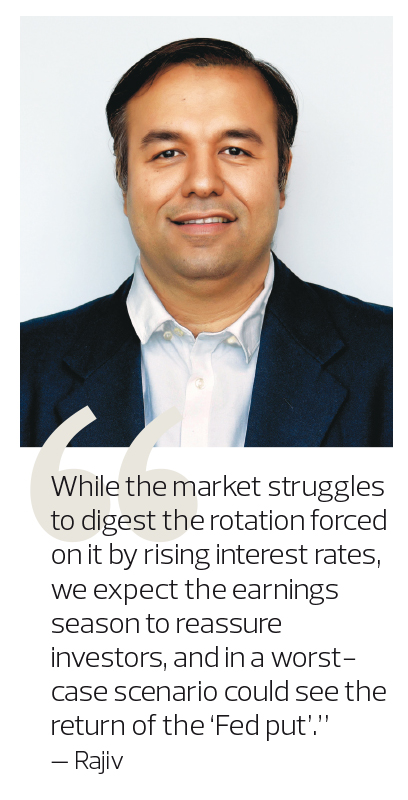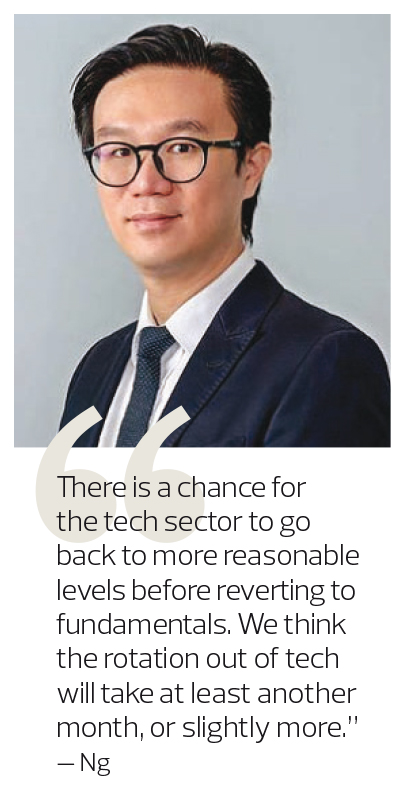
This article first appeared in Capital, The Edge Malaysia Weekly on January 31, 2022 - February 6, 2022
FINANCIAL markets kicked off 2022 on heightened volatility as the first US interest rate hike since the pandemic began looms large.
A sharp fall in US stocks has sparked a massive sell-off globally since the beginning of the year. In particular, the technology-heavy Nasdaq has plunged 13.4% year to date (YTD), followed by the S&P 500’s 8.7% and Dow Jones Industrial Average’s 6%.
Local tech stocks have not been spared either, as investors reduce their positions in anticipation of a rising interest rate environment. Compared with its peak last November, Bursa Malaysia’s Technology Index has shed nearly 20%. This compares with the benchmark FBM KLCI’s 0.7% dip over the same period.
Jeffrey Ng, head of Malaysia research and strategy at JP Morgan, cautions that the downward pressure on tech stocks is likely to persist for at least another month.
“The technology space is a bit crowded, so expectation- and valuation-wise, there is a chance for the sector to go back to more reasonable levels before reverting to fundamentals. We think the rotation out of tech will take at least another month, or slightly more,” he tells The Edge.
“Note that among the domestic mutual funds that have the mandate to only invest locally, almost everyone has technology as their heaviest sectoral investment, even heavier than their holdings in banks.”
For the time being, Ng is of the view that it is difficult to drive the tech sector higher unless there is a meaningful inflow of foreign funds into the local market. Even so, foreign investors are typically keen on large-cap stocks, and not necessarily the technology space as most of the counters are not constituents of the FBM KLCI. Inari Amertron Bhd is the sole tech representative following its inclusion on the benchmark index last December.
Nevertheless, Ng stresses that the fundamentals of the technology sector remain very favourable.
“If you like the tech sector and take a long-term view, it is really up to investors how to put a valuation on it. The fundamentals are very sound,” he says.
“If you track the electric vehicles (EVs) launched by every marque, how can we not be positive on that front? Malaysia is very blessed in the sense that we have contract manufacturers that are directly involved in this particular sector, so it is definitely one of the sectors that we are most excited about.”
Against the backdrop of rising interest rates this year, the market will be very much tilted towards sectors that will benefit from the interest rate hikes, mainly financial and, to a certain extent, property, says Ng.
He also favours healthcare and ESG-related themes (especially green energy), as well as those related to the reopening of the economy. “Based on the trends we have been tracking online — movements, bookings, room rates — they are all pointing towards a very strong domestic tourism-led recovery.”
Because of the threat stemming from the Omicron variant, the reopening theme took a big hit in 4Q2021. But Ng thinks the risk-reward ratio looks very favourable as the downside risks are minimal.
Elaborating on his positive view of the healthcare sector, he notes that hospital players have experienced pent-up demand in the last few quarters.
“During the Movement Control Order period, doing elective surgeries was difficult because of segregation. When the relaxation of movement restrictions kicks in, that will come through as patients cannot wait too long,” he says.
According to JP Morgan’s Malaysia Equity Strategy report released on Jan 14, IHH Healthcare Bhd and Genting Malaysia Bhd (GENM) are its large-cap picks because both stocks offer growth beyond the impact of reopening.
“Any deviation from IHH’s return on equity (ROE) strategy could see Mitsui increase its stake to take over the board. The downside is thus protected, in our view, while ROE could double with the disposal of non-performing assets,” says Ng.
“Meanwhile, 90% of GENM’s annual visitation is locally driven, offering strong recovery prospects. The potential opening of its outdoor theme park in 1H2022 could lift its profit above pre-Covid-19 levels.”
Why Malaysia is ‘underweight’ compared with regional peers
JP Morgan is “underweight” on Malaysian equities because it estimates the upside potential of the FBM KLCI to be just 7% this year, according to Rajiv Batra, strategist for Asean and emerging markets at JP Morgan.
“In other Asean countries, we are looking at an upside of 12% to 18% … Malaysia’s benchmark index is crowded [with] old-economy proxies, with some ESG-sensitive names and glove heavyweights,” he says.
Having said that, Rajiv highlights that the acceleration in the reopening of the economy, economic growth and new digital economy are among the catalysts that will drive markets in the region in terms of trade and manufacturing activities. This is evident from the broad-based return of foreign funds to Asean markets, after being a net seller of US$30 billion worth of equities in the region over the past five years.
“If you look at the past six months, Asean equities have received US$6 billion (RM25.2 billion) of inflows while Malaysia witnessed almost US$700 million. We expect portfolio inflows into Asean equities will continue to accelerate, driven by economic reopening and higher GDP growth differential versus that of North Asia,” he says.
“JP Morgan forecasts a GDP growth of 6.5% for Asean this year, versus 5% or less for North Asia. This means more money is chasing the higher growth differential.
“Asean equities are under-owned by foreign investors. Malaysia, being a part of Asean, will receive some inflows because the overall region benefits from the inflows. If there are more investable themes and interesting stock ideas, Malaysia could see more inflows.”
Rajiv observes that Malaysia’s mid-cap space has seen active foreign participation over the past five years, having generated returns at a higher compound annual growth rate (CAGR) than the benchmark index.
Pullback in risk assets looks overdone
Rajiv opines that the recent pullback in risk assets appears to be overdone, with a combination of technical indicators approaching oversold territory and bearish sentiment, suggesting that the market could be in the final stages of the current correction.
“While the market struggles to digest the rotation forced on it by rising interest rates, we expect the earnings season to reassure investors, and in a worst-case scenario could see the return of the ‘Fed put’,” he says.
The “Fed put” refers to the belief that the US Federal Reserve will intervene to ensure that the equity markets do not keep falling.
Rajiv points out that Asian equities, led by those in China and Hong Kong, have been outperforming amid a sharp correction in US stocks YTD.
“Overall, policy, valuation and macro dynamics look positive in China and the rest of Asia. Local markets are unlikely to be immune to higher volatility, or if there is any further downside in US equities,” he says.
JP Morgan has pencilled in a rate hike of 25 basis points per quarter, starting in March. As a result, the tighter liquidity will generally exert downward pressure on sectors that are trading at high valuation multiples, says Rajiv.
At its Federal Open Market Committee meeting last Wednesday, the US central bank sent a signal that it could start raising interest rates as early as March, in view of inflation holding well above 2% and a strong labour market.
Touching on commodities, Rajiv says JP Morgan’s year-end forecast for Brent crude and West Texas Intermediate oil is set at US$90 and US$86 per barrel respectively. If tensions between Russia and Ukraine intensify, oil prices could reach US$120 a barrel. Last Thursday, oil touched US$90 per barrel, the highest in seven years, as fears of a Russian invasion fuelled concerns about further disruptions to the oil market.
Ng advises investors to be selective when it comes to oil and gas (O&G) stocks as not all upstream operators will benefit from the rising prices. “You have to choose O&G players with a proven track record and recurring contracts. It is not like what we saw 10 to 15 years ago, when everyone benefited from the industry movements. Investors have to be more selective this time around.
“As we are positive on EV and solar, this means the world is likely to be more resistant to petroleum-driven energy. If upstream players do not increase their capital expenditure (capex), then Malaysian O&G players’ addressable markets will not grow.”
He expects less generous capex in the O&G sector as the focus is shifting towards renewable energy.
Touching on crude palm oil (CPO) companies and investor sensitivity to deforestation, Ng says the exclusion method used in investing criteria may continue to hinder interest in plantation stocks, which have underperformed despite a spike in CPO prices.
“We did an analysis of 10 big global funds, and 40% of them have an exclusion method, in that they cannot touch anything that has deforestation risks, regardless of whether they are Roundtable on Sustainable Palm Oil-certified or how green the plantation companies are. Another 40% have an engagement method, where they have to speak to the management and board to ensure all boxes are checked, while 20% are still drafting their ESG standards.”
Investors look forward to dividend yields of more than 5%
The defensive yield play is a theme worth looking at in 2022, observes Ng. With interest rate hikes coming into the picture, investors will be expecting dividend yields of more than 4% to 5%.
JP Morgan prefers British American Tobacco (M) Bhd, an attractive yield proxy with growth prospects.
“With its low foreign shareholding (excluding its parent company’s stake of 50%) of 10% versus 30% pre-Covid-19, we believe the risk-reward is right. Moreover, its consistent 100% dividend payout offers a FY2022 dividend yield of 7%,” he says.
Meanwhile, JP Morgan sees real estate investment trusts (REITs) as a laggard economic reopening play, despite positive news in the form of easing movement restrictions, the return of office workers (which has boosted traffic at nearby malls) and decreasing daily new Covid-19 cases in the Klang Valley.
Ng is of the view that retail participation will remain active this year, supported by an abundance of avenues for retail investors to participate at very affordable rates. Likewise, local institutions are poised to be more robust, given the need to rebalance their portfolios following the rotation between glove and tech stocks last year.
He is less concerned about the risk arising from a potential general election this year, after taking into account the stability Malaysia has enjoyed despite the several changes in government in recent years.
“The market is accustomed to this risk. Nonetheless, it is an uncertainty, but not as severe as what people think when compared with a few years ago.”
Save by subscribing to us for your print and/or digital copy.
P/S: The Edge is also available on Apple's App Store and Android's Google Play.



